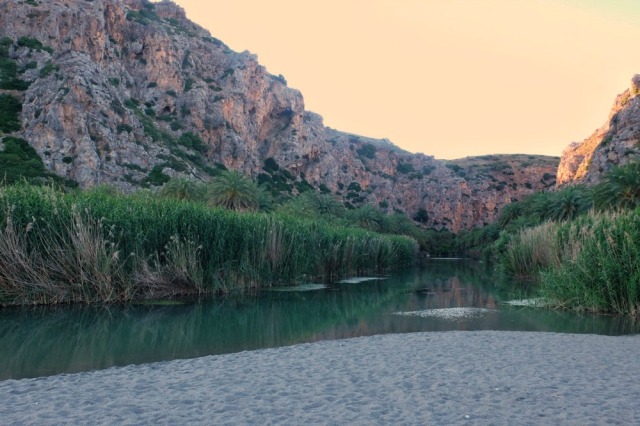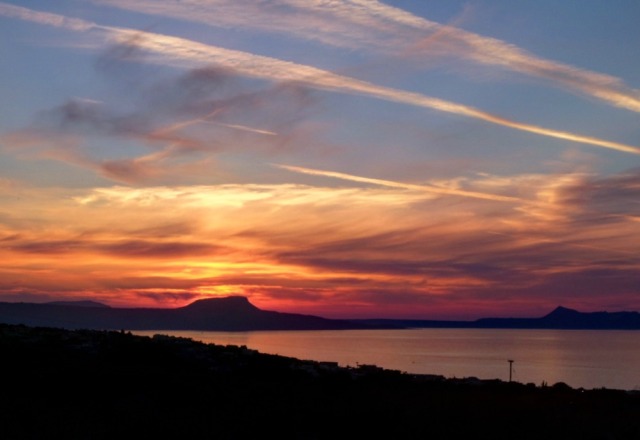6 weeks on Crete: Sometimes you get what you need

The centre of Crete’s Rethymno prefecture is shaped like a hand. The palm is Psiloritis, the mountain range that can be seen from every angle in this part of the island; the highest point of Mount Ida is your middle knuckle. From the mountains, ridges reach toward the north coast like fingers, narrow ledges with gaping gorges in between. The landscape means that two villages can be a mere 500 metres apart in space, but to actually reach the other, you need to drive up and down and around some five kilometres or more.
It was on one of these finger-like ridges that I found myself when I arrived on Crete in early May. I confess, when I arranged my temporary home — a 300-year-old Venetian house in the tiny village of Vergiana — I hadn’t thought about geography.
I spent the first two weeks adamant that I could cope without a car. Vergiana is small, with just a handful of houses and no shops or a taverna. The closest villages of Plevriana, Tripodi and Laga (all about one to two kilometres away on foot) aren’t much bigger — trust me, I investigated it all in those early days. On my first day, I hiked a forested trail that led from my village across to a taverna in Margarites, one of those places that would be a mere 500 metres away — if I had wings. Someone had described the trail to me as “a path.” Lost in Greek-English translation, I think, as it was a thigh-burning trek down one side of the gorge and up the other, battling overgrown thistles and mud holes. I was wearing flip-flops.
The next afternoon I rode the bike the owners had left me down to Perama, a town that’s best known for being the marijuana-dealing capital of Crete. Seriously. But it has a few supermarkets and I needed food. It was five kilometres one way, all downhill, riding the ridge toward the end of one fingertip on that hand-inspired map. And of course, what goes down must come back up. With a backpack of groceries.
I’ll be honest: for those first two weeks I alternated between feeling like a badass for having to work so hard just to buy bread, and scolding myself for not doing more research into where I’d actually be living. I had envisioned myself flitting around a whitewashed village in sundresses, drinking raki with old men in a taverna, then stumbling home to my house across the street. (Yes, I realize how obnoxious that sounds.) But here I was, in a tiny town of crumbling Venetian buildings with just some sheep and a stray dog (who I think gave me fleas at one point) to keep me company. And so I rented that car.
In hindsight, it’s silly to think my original plan was to just stay put in one town for two months — I had originally figured I’d only get wheels for the odd weekend trip to Chania or Sitia on the far ends of the island, or for a day down to the south coast. It’s silly because once I got the car, I started exploring and every place I explored was more charming and more stunning than the last, and I became hungry to see more and more of the island.
I will say now, no amount of hyperbole can explain how beautiful Crete is, so if I sound like a purple-prosed travel writer right now, that’s because it’s necessary. There are windswept canyons and white-sand beaches and snow-capped mountains and wildflower-filled fields and cliff faces that drop into the sea, all of it so shockingly beautiful that I spend most of my time driving around with my jaw gaped open.

Reaching Preveli Beach on the south coast Libyan Sea requires trekking down a cliff-side staircase — but it’s worth it
If I had missed driving up to the Nida Plateau, some 1,400 metres above sea level near the summit of Mount Ida, or missed driving south to the palm-tree lined beach of Preveli, or missed driving to the striking and tragic Melidoni Cave, I would have missed some of the most incredible scenery in all of my travels.
But more than just giving me pretty Instagrams, seeing the drama of the landscape strengthened my understanding of why and how Cretans are who they are, and what role I played as a visitor here.
Rural Crete isn’t an immediately easy place. For one, the landscape is rough terrain — steep cliffs and long distances make for a hardy, country-living community. But more importantly, Cretans are fiercely independent and resilient. Thanks to the island’s strategic location, they’ve been the site of territorial battles for centuries, from the Venetians to the Turks to the Nazis. There have been horrifying massacres on this island, and even today, it’s why so many of them dress all in black. They’re in mourning, they’ll tell you. Mourning for everyone who ever had to fight for the island. As someone here told me the other day, “Crete is not free. The whole world is not free.”

In 1824, during the Revolution against the Turks, more than 300 villagers tried to hide in Melidoni Cave; Turkish soldiers found their hiding spot, lit a fire, and asphyxiated them
They’ll also tell you that they’re not really Greek, they are Cretan. And that independent spirit carries over to everything, even to hospitality. Here, it’s assumed you can figure it out on your own. That you don’t need someone to babysit you. They’ll help you when you ask — don’t get me wrong, Cretans are so incredibly hospitable — but they won’t chase you to see if you’re okay. It’s assumed here that when you need something, you’ll ask for it, and that most of the time you’re doing just fine, thankyouverymuch.
When I first arrived on Crete, I cursed that I should be careful what I wish for. Before my trip, I had told myself that I wanted a small village, off the tourist trail, where I could be the only (or one of a few) tourists around, and live a sleepy life for two months. I had gotten it, and yet here I was complaining.
Which is why I think, in many ways, Crete knew me better than I knew myself. It was only after a few days of frustrating fits and starts that I realized Crete wasn’t going to just hand me my life for the next two months. I had to work. I had to be independent. And if I could embrace the challenge and stop focusing on what I didn’t have, I’d realize how much I did have.
It’s funny; as soon as I realized I couldn’t control my environment but could control my reactions to it, I got exactly what I wanted. Now, I have a few local tavernas where I bring my notebook or laptop in the neighbouring towns of Margarites, Eleftherna, and Angeliana — all places where when I arrive, I’m greeted with kisses and extra pours of raki. At one of the tavernas, they know my order before I even sit down (fried cheese and stuffed vegetables, if you were wondering). In Margarites, at the shop where I usually buy my wine, the owner’s mother baked me olive oil cookies the other day, telling her daughter to give them to that Canadian girl who lives all by herself in the small village across the gorge.
And that is the real beauty of Crete. As gorgeous as the scenery is, the hospitality is even more beautiful, in its own unique, independently spirited way. Nothing feels forced here, and that’s what I was getting wrong in the beginning. I was trying to force Crete to be what I had envisioned as “Tammy’s Greek Island Life.” But Crete will never let you tell it what to be. And once you embrace that, the island will reach its hand out to you, fingers stretching out to the Cretan Sea.



It is a beautiful post and I love the island of Crete. One of the most fantastic place.